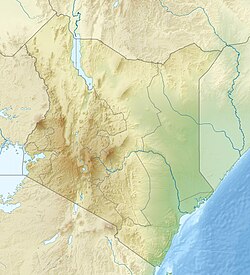Lamu Fort
| Lamu Fort | |
|---|---|
| Lamu, Kenya | |

Tower of Lamu Fort
|
|
| Coordinates | 2°16′10″S 40°54′08″E / 2.269346°S 40.90218°ECoordinates: 2°16′10″S 40°54′08″E / 2.269346°S 40.90218°E |
| Height | 2-story |
| Site information | |
| Open to the public |
Yes |
| Condition | Restored |
| Site history | |
| Built | c. 1813 |
Lamu Fort is a fortress in the town of Lamu in northeastern Kenya. Originally situated on the waterfront, the fort today it is located in a central position in the town, about 70 metres (230 ft) from the main jetty on the shore. The powerfully built two-story stone building contrasts with the Swahili architecture of the other buildings in the town.
Lamu Fort was built between 1813 and 1821 with Omani assistance. Initially it provided a base from which the Omanis consolidated their control of the East African coast but the town later lost its economic importance. During the British colonial period, and after the independence of Kenya, the fort was used as a prison. Today it houses an environmental museum and library, and is often used for community events.
Lamu Fort is a defensive structure that was erected at the southeast corner of the old stone town of Lamu. The fort was built beside the Pwani Mosque, the oldest known mosque in Lamu, with origins in the 14th century. The fort originally lay on the waterfront, which then ran along the main street of the town but has since retreated.
Thomas Boteler, who visited Lamu in 1823, described the fort as "a large square building, with a tower at each corner, but constructed so slightly that in all probability the discharge of its honeycombed ordnance would soon bring the whole fabric to the ground." It had a "large vaulted entrance ... [and] consisted of three stories of balconies, supported inside by arches. Captain W. F. W. Owen, who visited at the same time, noted that the fort was "one hundred yards square, and surrounded by walls from forty to fifty feet high."
Today the fort is in a central position in the town. It is situated about 70 metres (230 ft) from the main jetty on the shore. The fort today is a massive two-story stone building. The squat and powerful structure contrasts with the elegant Swahili architecture of the other buildings in the town.
Construction of the fort appears to have been started by Fumomadi, Sultan of Pate. The Mazrui leader Abdalla bin Hemed, in an uneasy alliance with Pate, was also involved in the construction. One story was built, but with the death of Funomadi in 1809 construction halted. In 1812 Lamu gained an unexpected victory at the Battle of Shela over the forces of Pate and Mombasa. The continued threat prompted them to call for help from Oman.Said bin Sultan, Sultan of Muscat and Oman (r. 1804–1856), was said to have assisted in the renewed construction, which began in 1813 and was completed around 1821.
...
Wikipedia

